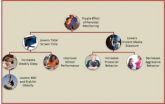(Press-News.org) A Yale University-led study has found that using more wood and less steel and concrete in building and bridge construction would substantially reduce global carbon dioxide emissions and fossil fuel consumption.
Despite an established forest conservation theory holding that tree harvesting should be strictly minimized to prevent the loss of biodiversity and to maintain carbon storage capacity, the new study shows that sustainable management of wood resources can achieve both goals while also reducing fossil fuel burning.
The results were published in the Journal of Sustainable Forestry.
In the comprehensive study, scientists from the Yale School of Forestry & Environmental Studies (F&ES) and the University of Washington's College of the Environment evaluated a range of scenarios, including leaving forests untouched, burning wood for energy, and using various solid wood products for construction.
The researchers calculated that the amount of wood harvested globally each year (3.4 billion cubic meters) is equivalent to only about 20 percent of annual wood growth (17 billion cubic meters), and much of that harvest is burned inefficiently for cooking. They found that increasing the wood harvest to the equivalent of 34 percent or more of annual wood growth would have profound and positive effects:
Between 14 and 31 percent of global CO2 emissions could be avoided by preventing emissions related to steel and concrete; by storing CO2 in the cellulose and lignin of wood products; and other factors.
About 12 to 19 percent of annual global fossil fuel consumption would be saved including savings achieved because scrap wood and unsellable materials could be burned for energy, replacing fossil fuel consumption.
Wood-based construction consumes much less energy than concrete or steel construction. For example, manufacturing a wood floor beam requires 80 megajoules (mj) of energy per square meter of floor space and emits 4 kilograms (kg) of CO2. By comparison, for the same square meter, a steel beam requires 516 mj and emits 40 kg of CO2, and a concrete slab floor requires 290 mj and emits 27 kg of CO2. Through efficient harvesting and product use, more CO2 is saved through the avoided emissions, materials, and wood energy than is lost from the harvested forest.
"This study shows still another reason to appreciate forests — and another reason to not let them be permanently cleared for agriculture," said Chadwick Oliver, Pinchot Professor of Forestry and Environmental Studies, Director of the Global Institute of Sustainable Forestry at F&ES and lead author of the new study. "Forest harvest creates a temporary opening that is needed by forest species such as butterflies and some birds and deer before it regrows to large trees. But conversion to agriculture is a permanent loss of all forest biodiversity."
The manufacture of steel, concrete, and brick accounts for about 16 percent of global fossil fuel consumption. When the transport and assembly of steel, concrete, and brick products is considered, its share of fossil fuel burning is closer to 20 to 30 percent, Oliver said.
Reductions in fossil fuel consumption and carbon emissions from construction will become increasingly critical as demand for new buildings, bridges and other infrastructure is expected to surge worldwide in the coming decades with economic development in Asia, Africa, and South America, according to a previous F&ES study. And innovative construction techniques are now making wood even more effective in bridges and mid-rise apartment buildings.
According to Oliver, carefully managed harvesting also reduces the likelihood of catastrophic wildfires.
And maintaining a mix of forest habitats and densities in non-reserved forests — in addition to keeping some global forests in reserves — would help preserve biodiversity in ecosystems worldwide, Oliver said. About 12.5 percent of the world's forests are currently located in reserves.
"Forests historically have had a diversity of habitats that different species need," Oliver said. "This diversity can be maintained by harvesting some of the forest growth. And the harvested wood will save fossil fuel and CO2 and provide jobs — giving local people more reason to keep the forests."
INFORMATION:The article, "Carbon, Fossil Fuel, and Biodiversity Mitigation with Woods and Forests," was co-authored by Nedal T. Nassar of the Yale School of Forestry & Environmental Studies and Bruce R. Lippke and James B. McCarter of the University of Washington.
Using more wood for construction can slash global reliance on fossil fuels
2014-03-31
ELSE PRESS RELEASES FROM THIS DATE:
Fast food giants' ads for healthier kids meals don't send the right message
2014-03-31
(Lebanon, NH, 3/31/14) — Fast food giants attempts at depicting healthier kids' meals frequently goes unnoticed by children ages 3 to 7 years old according to a new study by Dartmouth-Hitchcock Norris Cotton Cancer Center. In research published on March 31, 2014 in JAMA Pediatrics, Dartmouth researchers found that one-half to one-third of children did not identify milk when shown McDonald's and Burger King children's advertising images depicting that product. Sliced apples in Burger King's ads were identified as apples by only 10 percent of young viewers; instead most ...
EARTH Magazine: The trouble with turtles
2014-03-31
Alexandria, Va. – Turtles are the last major living vertebrate group to be placed firmly on the tree of life, and the arguments are getting messy. Three fields in particular — paleontology, developmental biology and microbiology/genomics — disagree about how, and from what, turtles may have evolved. In the latest EARTH Magazine feature story, contributing writer Naomi Lubick investigates how these creatures confound scientists on many levels — from their morphology in the paleontological record and in modern day turtles, to the analysis of their genome. Where do they belong ...
Limiting screen time yields mulitple benefits, ISU study finds
2014-03-31
AMES, Iowa – Parents may not always see it, but efforts to limit their children's screen time can make a difference. A new study, published in JAMA Pediatrics, found children get more sleep, do better in school, behave better and see other health benefits when parents limit content and the amount of time their children spend on the computer or in front of the TV.
Douglas Gentile, lead author and an associate professor of psychology at Iowa State, says the effect is not immediate and that makes it difficult for parents to recognize. As a result, parents may think it ...
Early cardiac risks linked to worse cognitive function in middle age
2014-03-31
Young adults with such cardiac risk factors as high blood pressure and elevated glucose levels have significantly worse cognitive function in middle age, according to a new study by dementia researchers at UC San Francisco.
The findings bolster the view that diseases like Alzheimer's develop over an individual's lifespan and may be set in motion early in life. And they offer hope that young adults may be able to lower their risk of developing dementia through diet and exercise, or even by taking medications.
"These cardiovascular risk factors are all quite modifiable," ...
Computer maps 21 distinct emotional expressions -- even 'happily disgusted'
2014-03-31
COLUMBUS, Ohio—Researchers at The Ohio State University have found a way for computers to recognize 21 distinct facial expressions—even expressions for complex or seemingly contradictory emotions such as "happily disgusted" or "sadly angry."
In the current issue of the Proceedings of the National Academy of Sciences, they report that they were able to more than triple the number of documented facial expressions that researchers can now use for cognitive analysis.
"We've gone beyond facial expressions for simple emotions like 'happy' or 'sad.' We found a strong consistency ...
Using your loaf to fight brain disease
2014-03-31
A humble ingredient of bread – baker's yeast – has provided scientists with remarkable new insights into understanding basic processes likely involved in diseases such as Parkinson's and cancer.
In a new study published today (Monday March 31) in the prestigious journal PNAS (Proceedings of the National Academy of Science), the team from Germany, Leicester, and Portugal detail a new advance – describing for the first time a key feature in cellular development linked to the onset of these devastating diseases.
The research team is from the University Medical Center Goettingen, ...
Can antibiotics cause autoimmunity?
2014-03-31
(PHILADELPHIA) -- The code for every gene includes a message at the end of it that signals the translation machinery to stop. Some diseases, such as cystic fibrosis and Duchenne muscular dystrophy, can result from mutations that insert this stop signal into the middle of an essential gene, causing the resulting protein to be truncated. Some antibiotics cause the cell's translation machinery to ignore the stop codons and are therefore being explored as a potential therapy for these diseases. But new research reported online in Proceedings of the National Academy of Sciences ...
Self-healing engineered muscle grown in the laboratory
2014-03-31
VIDEO:
After veins grow into the implanted engineered muscle fibers, blood cells can be seen traveling through them, sustaining and nourishing the new tissue.
Click here for more information.
DURHAM, N.C. -- Biomedical engineers have grown living skeletal muscle that looks a lot like the real thing. It contracts powerfully and rapidly, integrates into mice quickly, and for the first time, demonstrates the ability to heal itself both inside the laboratory and inside an animal.
The ...
Ancient whodunit may be solved: The microbes did it!
2014-03-31
Evidence left at the crime scene is abundant and global: Fossil remains show that sometime around 252 million years ago, about 90 percent of all species on Earth were suddenly wiped out — by far the largest of this planet's five known mass extinctions. But pinpointing the culprit has been difficult, and controversial.
Now, a team of MIT researchers may have found enough evidence to convict the guilty parties — but you'll need a microscope to see the killers.
The perpetrators, this new work suggests, were not asteroids, volcanoes, or raging coal fires, all of which have ...
Experimental cancer drug reverses schizophrenia in adolescent mice
2014-03-31
Johns Hopkins researchers say that an experimental anticancer compound appears to have reversed behaviors associated with schizophrenia and restored some lost brain cell function in adolescent mice with a rodent version of the devastating mental illness.
The drug is one of a class of compounds known as PAK inhibitors, which have been shown in animal experiments to confer some protection from brain damage due to Fragile X syndrome, an inherited disease in humans marked by mental retardation. There also is some evidence, experts say, suggesting PAK inhibitors could be used ...



